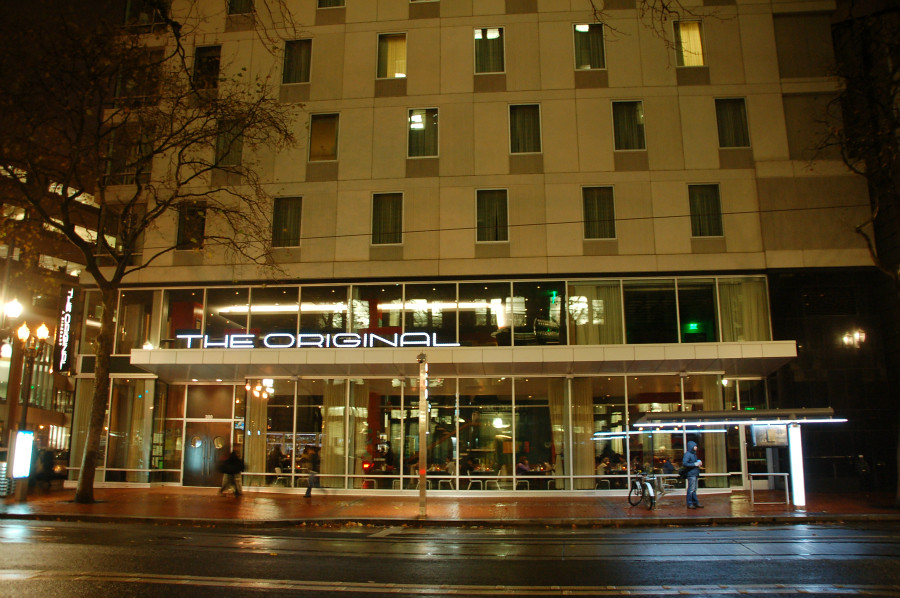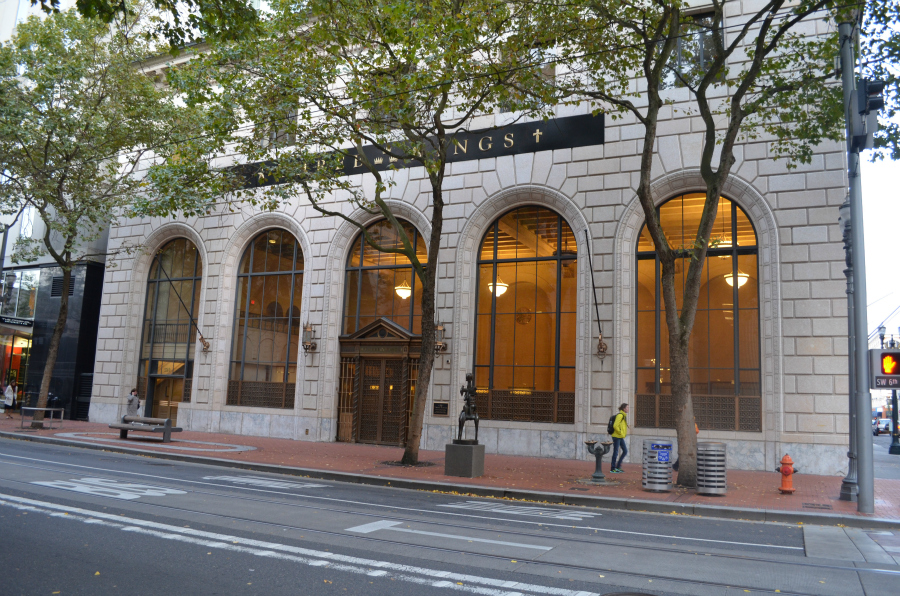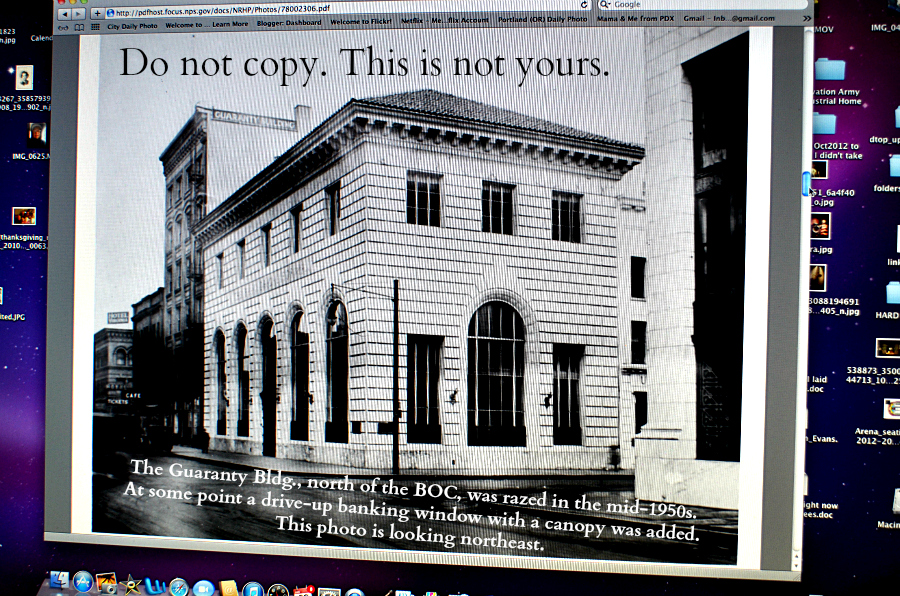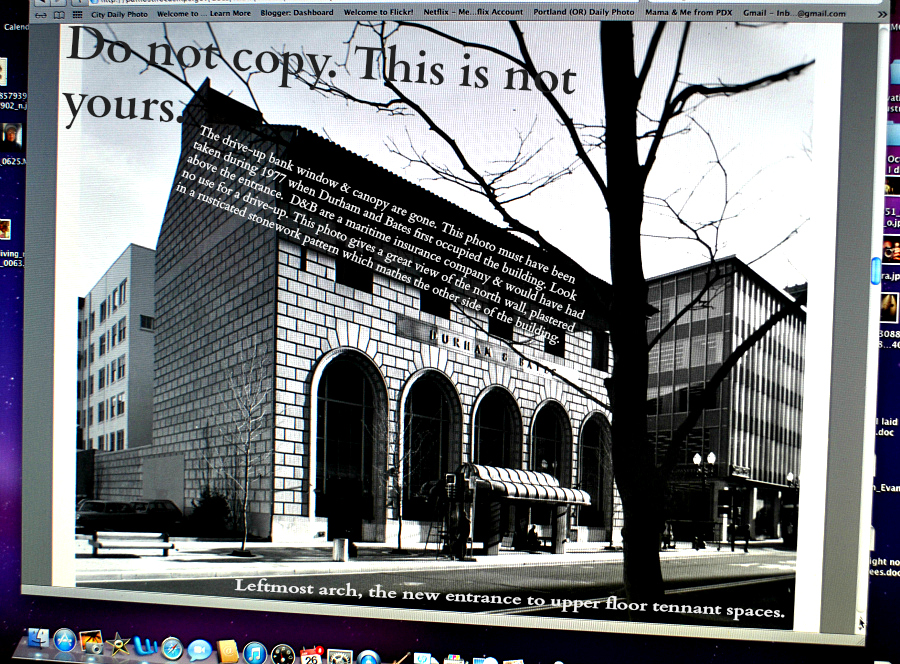
An eatery, The Original Dinerant, occupies the street level of the building to the north of the Bank of California. The BOC is just out of sight at the right of this building, next to the black-faced wall visible near the current-day TriMet bus shelter you see lit up for the night-time users of mass transit. Someone waits for a bus and appears to have a bicycle to place on the bike rack attached to the front of the bus.

Here's the Bank of California, just south of The Original Dinerant--notice the black-faced wall.
Vintage photos, part of the documentation used to place architect A. E. Doyle's Bank of California on the National Register of Historic Places. The application is dated as received on February 15, 1978, and approved on March 14, 1978.

Vintage photo shows the Guaranty Building which was adjacent to the Bank of California and north of it. The back of the photo says that it was taken in 1924. Since the grand opening photos are dated 1925, it may not have actually been occupied at the time this photo was taken. I wish I had a photo of the north end of the building, which was exposed with the demise of the Guaranty Building, complete with the drive-up window and the canopy. Below is the next best thing.

The north end of the Bank of California, taken during 1977 probably. Note the placement of the older style TriMet bus shelter here on this section of SW 6th Avenue--part of the then brand new Portland Transit Mall. In the second photo on today's post, a bench occupies this spot, put there when the Transit Mall was rebuilt. And you've already seen the style of bus shelter which replaced these iconic ones, in the top photo today.
From the paperwork submitted to the National Register of Historic Places:
Since the Bank of California's move to a new building in 1970, the structure has been occupied by The Security Bank of Oregon and, subsequently, the Oregon Bank. In 1977, ownership passed to Bankside Investors for occupancy by Durham and Bates, Inc., an insurance firm of pioneer beginnings in the Portland area. Since its construction, the exterior of the building has remained substantially unaltered, the only significant change being the addition of a drive-up banking window and canopy at the north end of the building. This was made possible by the razing of the six-story Guaranty Building which occupied the property immediately to the north until the mid-or late1950s. At this time, the newly exposed north wall was plastered in a rusticated stonework pattern simulating the west and south building elevations.
The imposing west facade of the bank building has five large arched windows which extend from the ground floor to a height of 28 feet above the sidewalk in recognition of the two-story banking lobby inside. Centered above these arches are smaller rectangular windows which serve the second floor office space almost 35 feet above the ground floor. Window frames are of painted steel. Above the second floor windows is a marble frieze and bracketed cornice which supports the Cordova Terracotta tile hipped roof typical of the Pallazzo style. The imposing rusticated "stonework" of the exterior walls and cornice are, in reality, cast terra-cotta executed with excellent craftsmanship. Only the marble base course and frieze are genuine.
The entrance to the building is through a handsome bronze portico set in the middle arched window opening at the west facade, and boasts a pair of bronze gates which can be slid in front of the double entrance doors. The original bronze-framed doors were removed a number of years ago and replaced by automatic tempered glass doors.
Recent modifications to the building, made just prior to occupancy by the present tenant, include the removal of the added drive-up window and canopy at the north wall, and the filling in of a door which was cut through to the parking lot.
A new entrance was installed in the northern-most window of the west wall to provide access to a new lobby serving the upper floor
tenant spaces. Presently, theTri-Metropolitan Transit District has contracted for the widening and brick-paving of the sidewalk on SixthAvenue. The brick texture and color, together with soon-to-be-installed trees and street furniture should further enhance the handsome building.

2 comments:
It's great you found such extensive details - I always wonder about the stories of buildings and it's not easy to fill in the blanks. Wonderful structure.
I like the look of that Dinerette. If you there alone you can watch people as they walk by.
Post a Comment